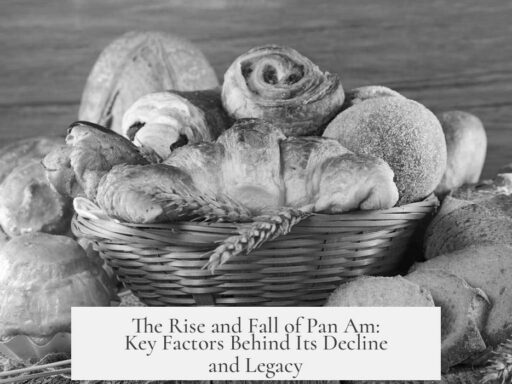Pan Am declined and failed due to a combination of strategic missteps, financial pressures, external shocks, and increased competition. The company’s initial global reach was unmatched, but it faltered without a strong domestic network, faced soaring fuel costs, struggled to adapt post-deregulation, and suffered from crippling legal and financial burdens.

Pan Am began as a global pioneer, connecting continents with its famed Clipper services. It built an extensive international network unmatched by competitors. However, Pan Am lacked a comprehensive domestic feeder system. While passengers could connect from domestic carriers at major hubs, the lack of seamless service weakened its market position compared to airlines with integrated domestic and international routes.
This structural weakness became a critical handicap in an evolving airline industry. Management recognized the need to build a domestic network but delayed decisive moves until deregulation forced their hand.

Fuel inefficiency added to Pan Am’s woes. Early jet aircraft consumed excessive fuel, which was manageable when prices were low. The 1973 oil embargo imposed by the Organization of Arab Petroleum Exporting Countries (OAPEC) sharply increased oil prices from about $3 to $12 a barrel overnight. For Pan Am, this translated to an unprecedented $200 million annual increase in fuel expenses. To offset rising costs, ticket prices increased, leading to lower passenger demand. This loss of traffic reduced revenue and magnified the company’s financial strain. International competitors, often with more efficient fleets or balanced domestic/international networks, capitalized on the situation.
The Airline Deregulation Act of 1978 represented a turning point. It allowed airlines to select routes more freely, removing government control over pricing and market entry. Before deregulation, Pan Am maintained limited domestic routes, mainly between New York and Miami, Los Angeles, and San Francisco. Deregulation pushed Pan Am to quickly establish a domestic network.

Pan Am acquired National Airlines in 1980 following a costly bidding war with Texas International Airways. While the acquisition allowed Pan Am to enter the domestic market, it severely drained cash reserves and required heavy borrowing. The integration of National’s routes was costly and complex. Subsequent asset sales followed: in 1981, Pan Am sold its iconic New York headquarters for cash, and in 1985, it sold its Pacific division to United Airlines. These sales reflected ongoing financial distress and a need to streamline operations via cost-cutting.
The December 21, 1988, Lockerbie bombing (Pan Am Flight 103) inflicted severe damage. A terrorist bomb exploded shortly after departing London, killing all aboard. Pan Am’s minimal security measures—partly the result of earlier cost cutting—came under strong scrutiny. The resulting lawsuits from victims’ families cost Pan Am approximately $350 million. The incident tarnished the airline’s reputation and precipitated further route losses, as carriers like United Airlines snapped up Pan Am’s transatlantic routes.

In the final years, Pan Am struggled to survive amid mounting losses exceeding $3 million daily. Delta Airlines initially provided financial support but withdrew funding by the end of 1991, realizing the situation was unsalvageable. Pan Am ceased operations on December 4, 1991. Subsequent attempts to revive the brand failed, and assets were sold or absorbed by competitors. The frequent flyer program merged into Delta’s SkyMiles, and the only enduring element of Pan Am was its Flight Academy in Miami.
| Cause | Impact on Pan Am |
|---|---|
| Lack of Domestic Feeder Routes | Reduced passenger convenience and competitiveness in the U.S. market |
| Fuel-Inefficient Jets & 1973 Oil Crisis | Massive increase in operating costs; pricing pressures; empty seats |
| Airline Deregulation & National Airlines Acquisition | Forced rapid expansion into domestic market; heavy debt |
| Financial Strain & Asset Sales | Cash shortages; loss of key assets; cost-cutting |
| Lockerbie Bombing (Flight 103) | Legal liabilities; loss of reputation; route sales |
| Failed Bailouts and Continued Losses | Operational shutdown in 1991; inability to finance ongoing operations |
- Pan Am’s early global dominance rested on pioneering international routes, unmatched for decades.
- The lack of a domestic feeder network limited its ability to compete with integrated carriers.
- Fuel-inefficient aircraft and the 1973 oil crisis caused severe cost increases and passenger decline.
- Deregulation forced Pan Am to buy National Airlines, straining its finances and operations.
- The 1988 Lockerbie bombing produced costly lawsuits and eroded customer confidence.
- Ongoing financial losses led to asset sales, failed bailouts, and eventual collapse in 1991.
- Only the Pan Am Flight Academy and brand legacy survive today.
How and Why Did Pan Am Decline and Fail?

Pan Am declined and failed primarily due to its lack of a strong domestic feeder network, crippling fuel inefficiencies exacerbated by the 1973 oil crisis, costly attempts to expand post-deregulation, financial strain from asset sales, the devastating Lockerbie bombing, and ultimately insurmountable financial losses despite attempted rescues.
But wait, there’s a fascinating story behind all this—a saga that reads like a rollercoaster ride in the golden age of aviation. Let’s unpack this piece by piece, tracing Pan Am’s rise, stumble, and ultimate fall.

The Golden Era: Pan Am’s Incredible Rise
Once upon a time, Pan American World Airways was king of the skies. Starting humbly with a single route from Key West to Havana, it transformed into the world’s pioneering international airline. Its famous Clipper service wasn’t just a fleet of planes—it was a flying symbol of luxury and reliability, setting the global standard for air travel.

Pan Am’s mystique wasn’t just marketing fluff. It operated a vast network spanning nearly every corner of the globe, unlike any competitor at the time. But, as they say, what goes up can come down—often unexpectedly.
Where Did It All Begin to Go Wrong?
One of Pan Am’s biggest strategic blunders came early on—its persistent failure to build a robust domestic feeder network. While competitors developed nationwide routes chiming perfectly with their international service, Pan Am mostly lacked this vital component. Imagine flying from a small town to an international destination—you’d expect one smooth journey. Instead, passengers often had to change airlines, juggling different tickets, terminals, and schedules. Not exactly the seamless experience travelers love.
This deficiency might seem trivial, but it’s like trying to fill a giant bucket with water through a tiny straw — eventually, the flow isn’t enough to sustain the big operation. Other airlines that owned or partnered with domestic carriers could funnel passengers directly into their international flights. Pan Am had no such luxury for years.
The Jet Age and the Fuel Nightmare
On top of its domestic issues, Pan Am bet big on early jet technology. Their Clipper jets were marvelous, but boy, did they guzzle fuel. Before the 1970s, cheap oil disguised this problem. Airlines and passengers were largely indifferent to fuel consumption when jet fuel was pocket change—well, pocket change for governments and giant corporations anyway.
Then came 1973. The Organization of Arab Petroleum Exporting Countries (OAPEC) slapped the world with an oil embargo. Fuel prices soared from about $3 per barrel to $12 almost overnight. Panic!
For Pan Am, this was catastrophic. Their annual fuel costs ballooned by roughly $200 million—a staggering amount at the time. To cover these skyrocketing expenses, Pan Am raised ticket prices. But higher fares scared away travelers, especially tourists. To make matters worse, competition on international routes intensified, causing planes to fly half empty. The perfect storm for financial hemorrhage.
Deregulation: When the Rules Changed, and Pan Am Wasn’t Ready
Fast forward to 1978—enter the Airline Deregulation Act, signed by President Jimmy Carter. The new law changed everything, allowing airlines to freely select routes and compete more aggressively.
For Pan Am, deregulation was a wake-up call. It *had to* build a substantial domestic network if it wanted to stay in the game. But here’s the catch—its domestic routes were limited to just a few major cities: New York to Miami, Los Angeles, and San Francisco.
Management made their move, targeting National Airlines as the vehicle to quickly develop domestic feeder routes. However, a bidding war with Texas International Airways inflated the price. Pan Am won the battle but paid dearly.
The Cost of Building a Domestic Network
The National Airlines acquisition in 1980 was both a blessing and a curse. It gave Pan Am a starting domestic base, but it drained the company’s cash reserves and forced it to take on heavy loans.
To stay afloat, Pan Am sold its iconic headquarters in New York’s Pan Am Building to the Metropolitan Insurance Company, raking in some much-needed cash. A few years later, they sold their Pacific Division to United Airlines, further trimming the company down. Eventually, relentless cost-cutting became the company’s daily routine—cut flight frequencies, delay aircraft purchases, lay off employees—all to keep the doors open.
The Lockerbie Tragedy: A Blow from Which Pan Am Could Not Recover
If financial woes and strategic errors weren’t enough, disaster struck on December 21, 1988. Pan Am Flight 103, shortly after taking off from London’s Heathrow airport, exploded midair from a terrorist bomb. This horrific event, known as the Lockerbie bombing, resulted in 270 deaths.
Years of cost-cutting had left security at the airline operating just the legal minimum. Critics argued that more could have been done to protect passengers, and Pan Am’s image took a massive hit. A long, drawn-out lawsuit from family members drained hundreds of millions from the airline—around $350 million just in legal costs.
Pan Am’s financial position was butchered again—routes to Europe, once the crown jewels, were sold off to United Airlines. The company was bleeding money and reputation simultaneously.
The Final Years: Trying to Keep the Wings Aloft
Despite everything, Pan Am clung to life. They scrambled, fought creditors, and battled ongoing lawsuits from the Flight 103 tragedy. Delta Airlines came to the rescue in 1991 with loans and route purchases, hoping to hold the airline up.
However, the financial losses were massive—over $3 million lost daily. Delta soon realized this was like pouring water into a bottomless bucket. In December 1991, Delta pulled the plug. Pan Am made its last flight on December 4th. It was the end of an era.
Attempts at Revival and the Legacy Left Behind
Pan Am tried to fight back. It sued Delta for backing out of the loan deal and explored ways to restart operations, but the damage was irreparable. Its remaining planes and routes were sold off or absorbed by other airlines. Frequent flyer members were absorbed into Delta’s SkyMiles program, ending whatever loyalty Pan Am had left.
Today, the Pan Am name survives only through the Pan Am Flight Academy in Miami, Florida—where pilots are still trained under that legendary banner. It’s a bittersweet legacy, a nod to a trailblazer that helped define international aviation but couldn’t reinvent itself fast enough when the skies got stormy.
Key Lessons from Pan Am’s Decline
- Adaptability is crucial. Great success in the past doesn’t guarantee survival without agile responses to external changes—like deregulation and oil crises.
- Strong infrastructure matters. Building a domestic feeder system wasn’t just a convenience; it was essential in a changing competitive landscape.
- Technological shifts must be balanced with efficiency. Early jets looked glamorous but sucked fuel like a vacuum cleaner—costing the company dearly post-oil shock.
- Risk management, especially in security, can save a company’s reputation—and future. Under-investing in safety to cut costs may save money short-term but creates catastrophic long-term consequences.
- Financial prudence is key. Overpaying in acquisitions and selling off assets to cover debts may provide temporary relief but can weaken a company structurally.
So, Why Should You Care about Pan Am Today?
Because Pan Am’s story is a masterclass in business rise and fall. It reminds us that being first and being famous aren’t enough. Sustainability, flexibility, and foresight matter more than ever.
Flying today may seem simple—thank airlines like Pan Am who took epic risks to bring the world closer. But the skies are ruthless; yesterday’s pioneer can become today’s cautionary tale. What other airlines will face similar fates if they don’t learn Pan Am’s lessons?
If you want to dig deeper, Skygods: The Fall of Pan Am is a fantastic read packed with insider analysis and juicy details that bring the story to life.
Summary Table: Why Pan Am Declined and Failed
| Key Topic | Causes & Consequences |
|---|---|
| Lack of Domestic Feeder Routes | Failed to build a strong domestic network, unlike competitors, hurting passenger flow. |
| Fuel-Inefficient Jets & 1973 Oil Crisis | Early jets consumed massive fuel; oil embargo caused fuel costs to quadruple, drastically raising expenses. |
| Airline Deregulation (1978) | Forced development of domestic routes; expensive National Airlines acquisition drained finances. |
| Financial Struggles | Asset sales, cost cutting, loans—constant financial instability. |
| Lockerbie Bombing (1988) | Security lapses, costly lawsuits, reputation damage, loss of routes. |
| Continued Losses & Failed Bailouts | Delta’s short-term financing failed; final shutdown in 1991. |
| Failed Revival Attempts & Legacy | Legal battles unsuccessful; only flight academy and brand remain. |
Pan Am zoomed through decades with fanfare and pioneering glory. Its fall? A tale of missed chances, harsh economics, and real-world crises that even the mightiest couldn’t outrun. Fascinating, isn’t it?




